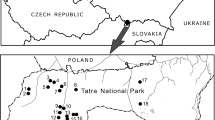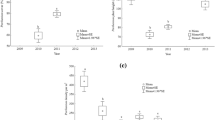Abstract
Steller chamaejasme L. (S. chamaejasme for short) is one of the most noxious unpalatable weeds in China, which has been frequently reported its negative interaction (i.e. competition and allelopathy) with other herbaceous species in grasslands. This study compared species diversity, biomass and sexual reproduction of herbaceous plants in meadows with S. chamaejasme and in open meadows without S. chamaejasme in overgrazing meadows on the Tibetan Plateau in China to determine whether positive facilitation exist between S. chamaejasme and other herbaceous species under livestock’s overgrazing. The results showed that there are more herbaceous species in meadows with S. chamaejasme than those in open meadows (35s and 30s, respectively). Diversity index and above-ground biomass were also significantly higher in meadows with S. chamaejasme. There were 39% (11/28) of all species with sexual reproduction found in meadows with S. chamaejasme, which was 7 times more than those in open meadows. Our study showed that S. chamaejasme could provide biotic refuge for neighboring plants and preserve plant diversity from livestock’s overgrazing in alpine meadows on the Tibetan Plateau. It also suggested that inter-specific facilitation between S. chamaejasme and other herbaceous species may play a key role in overgrazing alpine meadows.
Similar content being viewed by others
Reference
Atsatt PR, O’Dowd DJ (1976) Plant defense guilds. Science 193: 24–29. DOI: 10.1126/science.193.4247.24
Baraza E, Zamora R, Ho’dar JA (2006) Conditional outcomes in plant-herbivore interactions: neighbors matter. Oikos 113: 148–156. DOI: 10.1111/j.0030-1299.2006.14265.x
Barbour MG, Burk JH, Pitts WD (1987) Terrestrial plant ecology. Benjamin/Cummings, Menlo Park, CA, USA. pp 16–17.
Bossuy B, Defre B, Hoffmann M (2005) Abundance and flowering success patterns in ashort-term grazing grassland: early evidence of facilitation. Journal of Ecology 93: 1104–1114. DOI: 10.1111/j.1365-2745.2005.01059.x
Callaway RM (1995) Positive interactions among plants. Botanical Review 61: 306–349. DOI: 10.1007/BF02912621
Callaway RM (1997) Positive interactions in plant communities and the individualistic-continuum concept. Oecologia 112: 143–149. DOI: 10.1007/s004420050293
Callaway RM, Kikvidze Z, Kikodze D (2000) Facilitation by unpalatable weeds may conserve plant diversity in overgrazing meadows in the Caucasus Mountains. Oikos 89: 275–282. DOI: 10.1034/j.1600-0706.2000.890208.x
Callaway RM, Kikodze D, Chiboshvili M, Khetsuriani L (2005) Unpalatable plants protect neighbors from grazing and increase plant community diversity. Ecology 86: 1856–1862. DOI: 10.1890/04-0784
Callaway RM, Walker LR (1997) Competition and facilitation: a synthetic approach to interactions in plant communities. Ecology 78: 1567–1578. DOI: 10.1890/0012-9658(1997)078[1958:CAFASA]2.0.CO;2
Chinese Soil Taxonomy Research Group (1995) Chinese Soil Taxonomy. Science Press, Beijing, China. pp 20.
Coffin DP, Lauenroth WK (1992) Spatial variability in seed production of the perennial bunchgrass Boutelouagracilis (Gramineae). American Journal of Botany 79: 347–353.
Choler P, Michalet, R, Callaway RM (2001) Facilitationand competition on gradients in alpine plant communities. Ecology 82: 3295–3308.
Fourest E, Volesky B (1996) Contribution of Sulfonate Groups and Alginate to Heavy Metal Biosorption by the Dry Biomass of Sargassum fluitans. Environment Science Technology 30: 277–282. DOI: 10.1021/es950315s
Holmes RD, Jepson-Innes KA (1989) A neighborhood analysis of herbivory in Bouteloua gracilis. Ecology 70: 971–976.
Huang ZJ, Zhou SQ (1993) The important toxic plant on grassland-Stellera chamaejasme L. Prataculture and Animal Husbandry 4: 22–27. (In Chinese)
Kelley SE, Clay K (1987) Interspecific interactions and the maintenance of genotypic variation within two perennial grasses. Evolution 41: 92–103.
King EG, Stanton ML (2008) Facilitative effects of aloe shrubs on grass establishment, growth, and reproduction in degraded Kenyan rangelands: implications for restoration. Restoration Ecology 3: 464–474. DOI: 10.1111/j.1526-100X.2007.00310.x
Liu Y, Long R, Yao T (2004) Research progress on Stellera chamajasme L. in grassland. Prataculture Science 21: 55–61 (In Chinese).
Manier D, Hobbs NT (2006) Large herbivores influence the composition and diversity of shrub-steppe communities in the Rocky Mountains, USA. Oecologia 146: 641–651. DOI: 10.1007/s00442-005-0065-9
Milchunas DG, Noy-Meir I (2002) Grazing refuges, external avoidance of herbivory and plant diversity. Oikos 99: 113–130. DOI: 10.1034/j.1600-0706.2002.990112.x
National Research Council (1994) Rangeland health. National Academy Press, Washington, USA. pp 85–86.
Noy-Meir I (1973) Desert ecosystems: environment and producers. Annual Review of Ecology and Systematics 4: 25–52.
Oesterheld M, Oyarzabal M (2004) Grass-to-grass protection from grazing in a semi-arid steppe. Facilitation, competition, and mass effect. Oikos 107: 576–582. DOI: 10.1111/j.0030-1299.2004.13442.x
Osem Y, Perevolotsky A, Kigel J (2007) Interactive effects of grazing and shrubs on the annual plant community in semiarid Mediterranean shrub lands. Journal of Vegetation Science 18: 869–878. DOI: 10.1111/j.1654-1103.2007.tb026 03.x
Pahlsson L (1974) Influence of vegetation on microclimate and soil moisture on a Scanianhill. Oikos 25: 176–186.
Rebollo S, Milchunas DG, Noy-Meir I (2002) The role of a spiny plant refuge in structuring grazing shortgrass steppe plant communities. Oikos 98: 53–64. DOI: 10.1034/j.1600-0706.2002.980106.x
Sala OE, Parton WJ, Joyce LA, Lauenroth WK (1988) Primary production of the central grassland region of the United States. Ecology 69: 40–45. DOI: 10.2307/1943158
Sims PL (1988) Grasslands. In: Barbour M.G. and Billings, W.D. (eds.), North American terrestrial vegetation, Cambridge University Press, Cambridge, UK. pp 265–286.
Sun G, Luo P, Wu N, et al. (2009) Stellera chamaejasme L. increases soil N availability, turnover rates and microbial biomass in an alpine meadow ecosystem on the eastern Tibetan Plateau of China. Soil Biology and Biochemistry 41: 86–91. DOI: 10.1016/j.soilbio.2008.09.022
Suzuki RO, Suzuki SN (2011) Facilitative and competitive effects of a large species with defensive traits on a grazing-adapted, small species in a long-term deer grazing habitat. Plant Ecology 212: 343–351. DOI: 10.1007/s11258-010-9826-6
Wang J, Pu XP, Cao ZZ, et al. (2011) Study on the grassland type and productivity of Tanzi pasture in Danchang County. Pratacultural Science 28: 420–425 (In Chinese).
Wang Y, Gilbert MG (2007) Stellera Linnaeus. In: Wu ZY. and Raven PH (eds.), Flora of China. Science Press, Beijing, China. p 250.
Whittaker RH (1975) Communities and ecosystems. 2nd ed. Macmillan, New York. pp. 29–30.
Zhang ZQ, Zhang YH, Sun H (2011) The reproductive biology of Stellera chamaejasme (Thymelaeaceae): A self-incompatible weed with specialized flowers. Flora 206: 567–574. DOI: 10.1016/j.flora.2011.01.008
Zhou S, Huang Z, An R (1998) Preliminary study on the allelopathy of Stellera chamaejasme. Grassland of China 2: 52–55. (In Chinese)
Author information
Authors and Affiliations
Corresponding authors
Rights and permissions
About this article
Cite this article
Cheng, W., Sun, G., Du, Lf. et al. Unpalatable weed Stellera chamaejasme L. provides biotic refuge for neighboring species and conserves plant diversity in overgrazing alpine meadows on the Tibetan Plateau in China. J. Mt. Sci. 11, 746–754 (2014). https://doi.org/10.1007/s11629-013-2729-y
Received:
Accepted:
Published:
Issue Date:
DOI: https://doi.org/10.1007/s11629-013-2729-y




